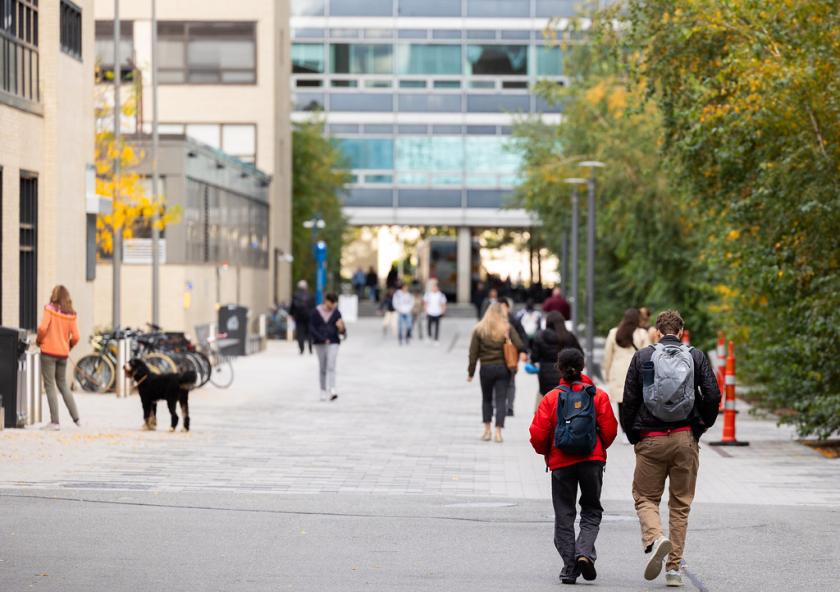
Exploring the value of science-based targets for higher education institutions

When it comes to mitigating climate change, industry has shifted to an increasingly metrics-driven approach—with a focus on carbon accounting, environmental, social and governance (ESG) reporting, and setting ambitious emission reduction targets. To support these companies’ intentions and efforts, the Science Based Targets initiative (SBTi) provides guidance on how they can develop science-based targets (SBTs) that offer a clear path forward in reducing greenhouse gas emissions. As the private sector has moved toward quantifiable, clearly defined, and measurable targets using SBTi guidelines, so have U.S-based Higher Education Institutions (HEIs)—but does such an alignment add value to these HEIs’ sustainability efforts?
A team at MIT is exploring the similarities and differences between how HEIs and corporations plan to achieve their climate targets and whether it is appropriate for HEIs to adopt SBTs. Since SBTs are geared toward corporations, which have their own unique motivations and scopes with regard to achieving climate goals, a central question is whether they are as relevant or useful for HEIs.
Through their research, Leela Velautham, Postdoctoral Researcher; Jeremy Gregory, Executive Director of the MIT Climate & Sustainability Consortium; and Julie Newman, Director of Sustainability bring together diverse perspectives on SBTs, corporate sustainability target setting, and sustainability in higher education—offering an overview of potential benefits and disadvantages of HEIs adopting SBTs. Their findings were recently published in The International Journal of Sustainability in Higher Education in a paper entitled “Science-Based Targets for Higher Education? Evaluating Alignment between Ivy+ Climate Action Plans and the Science Based Targets Initiative’s Net-Zero Standards.”
Knowledge for future opportunities
“Setting science-based targets with SBTi is nowadays, for better or worse, viewed as synonymous with serious corporate climate intent and action,” said Velautham. “Studying the alignment between HEI sustainability targets and climate action plans and SBTi’s general protocol is a way to look at differences between how higher education and industry are approaching target setting and decarbonization.”
Velautham and the team used the degree of alignment between the two to assess how corporate-like Ivy+ climate actions plans are. The team also used the major differences as a starting point to provide recommendations for considerations if higher education-specific SBTi guidelines were ever to be produced. Their analysis reviewed 24 Ivy+ schools’ climate action plans against criteria from the SBTi corporate protocol.
“As a result of this analysis, we sought to understand the ways in which adoption of SBTs could serve as either drivers or barriers to climate action on campus, and ways in which they might either aid or limit the ability of HEIs to act as agents of change in this space,” Velautham said.
Some strategy overlap, some significant differences
The team found some areas of overlap between the Ivy+ HEI net-zero strategies and SBTi’s corporate guidelines. The majority of HEIs surveyed had both short and long-term targets and were investing in renewable electricity procurement that would bring them in line with SBTi’s ambitious scope 2 (emissions from purchased electricity and heat) targets in the short term. There were some significant differences, however, between SBTi’s guidelines and the Ivy+ HEI’s strategies to reach net-zero. For example, the majority of sampled HEIs did not yet have quantitative scope 3 (all indirect value chain) targets, intended to use offsets to meet short-term targets, and demonstrated a lower absolute linear annual reduction of scope 1 emissions (which an organization makes directly) and scope 2 emissions than that recommended by SBTi.
A few other notable findings were the schools’ divergent positions on the use of offsets, their differing renewable energy procurement strategies based on geographical location, and while many sustainability offices were doing work on reducing scope 3 categories on their campuses (e.g., water, waste, commute, business air travel), this had not translated into more formal, quantitative scope 3 emission reduction targets.
MIT’s sustainability efforts
MIT’s Fast Forward: Climate Action Plan for the Decade mobilizes its community to address the climate crisis, focusing on investment in new research and applied technologies and immediate action on campus to achieve net-zero carbon emissions by 2026, with a goal of eliminating direct emissions by 2050.
Throughout her post-doc, Velautham has been studying how MIT is decarbonizing as an institution and to uncover similarities and differences between its approach compared to some MCSC member companies, in the hopes to inform how to accelerate both sectors.
“I’m particularly interested in how MIT’s status as a research and educational institution (as opposed to a business) informs both expectations of and the scope of how it is choosing to meet its 2026 net-zero and 2050 zero-direct emissions targe—something I hope to look into further in the future,” she concluded.

